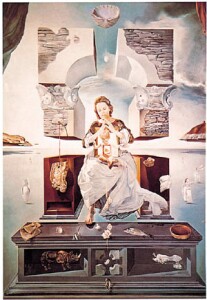Madonna Dalì

Poster Dalì Madonna - cm 40x50
| Cod | Dimensiuni în cm | Greutate pe mp |
Preț € |
Cant. comandă |
||
|---|---|---|---|---|---|---|
| Foaie | ||||||
| P70L | 70 | 100 | 300 | 9,30 | ||
| P70M | 40 | 50 | 300 | 3,30 | ||
| P70S | 24 | 30 | 250 | 1,80 | ||
Madonna Dalì -
Salvador Domingo Felipe Jacinto Dalí i Domènech, Marquis de Púbol (May 11, 1904 – January 23, 1989), commonly known as Salvador Dalí (Catalan pronunciation: [s??????o ????i]), was a prominent Spanish Catalan surrealist painter born in Figueres.
Dalí was a skilled draftsman, best known for the striking and bizarre images in his surrealist work. His painterly skills are often attributed to the influence of Renaissance masters.[1][2] His best-known work, The Persistence of Memory, was completed in 1931. Dalí's expansive artistic repertoire includes film, sculpture, and photography, in collaboration with a range of artists in a variety of media.
Dalí attributed his "love of everything that is gilded and excessive, my passion for luxury and my love of oriental clothes"[3] to a self-styled "Arab lineage," claiming that his ancestors were descended from the Moors.
Dalí was highly imaginative, and also had an affinity for partaking in unusual and grandiose behavior. His eccentric manner and attention-grabbing public actions sometimes drew more attention than his artwork to the dismay of those who held his work in high esteem and to the irritation of his critics.
Biography
Salvador Doménec Felip Jacint Dalí i Domènech was born on May 11, 1904 at 8:45 a.m. GMT[5] in the town of Figueres, in the Empordà region, close to the French border in Catalonia, Spain.[6] Dalí's older brother, also named Salvador (born October 12, 1901), had died of gastroenteritis nine months earlier, on August 1, 1903. His father, Salvador Dalí i Cusí, was a middle-class lawyer and notary[7] whose strict disciplinary approach was tempered by his wife, Felipa Domenech Ferrés, who encouraged her son's artistic endeavors.[8] When he was five, Dalí was taken to his brother's grave and told by his parents that he was his brother's reincarnation,[9] a concept which he came to believe.[10] Of his brother, Dalí said, "...[we] resembled each other like two drops of water, but we had different reflections."[11] He "was probably a first version of myself but conceived too much in the absolute."
Dalí also had a sister, Ana María, who was three years younger.[7] In 1949, she published a book about her brother, Dalí As Seen By His Sister.[12] His childhood friends included future FC Barcelona footballers Sagibarba and Josep Samitier. During holidays at the Catalan resort of Cadaqués, the trio played football together.
Dalí attended drawing school. In 1916, Dalí also discovered modern painting on a summer vacation trip to Cadaqués with the family of Ramon Pichot, a local artist who made regular trips to Paris.[7] The next year, Dalí's father organized an exhibition of his charcoal drawings in their family home. He had his first public exhibition at the Municipal Theater in Figueres in 1919.
In February 1921, Dalí's mother died of breast cancer. Dalí was sixteen years old; he later said his mother's death "was the greatest blow I had experienced in my life. I worshipped her... I could not resign myself to the loss of a being on whom I counted to make invisible the unavoidable blemishes of my soul."[13] After her death, Dalí's father married his deceased wife's sister. Dalí did not resent this marriage, because he had a great love and respect for his aunt.
